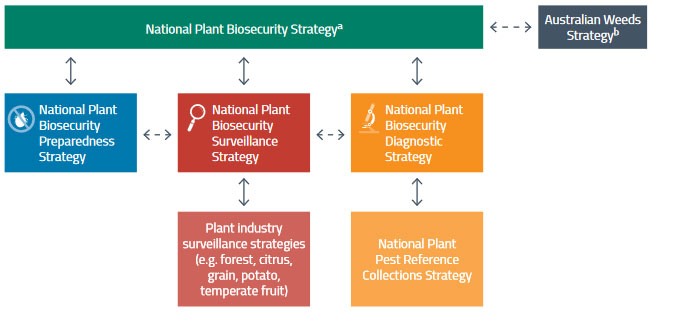Australia’s plant biosecurity system is built on a shared responsibility between a diverse range of stakeholders including all levels of government, plant industry bodies, growers, research organisations, environmental groups, natural resource managers, supply chains and the wider community (e.g. Indigenous individuals and communities, education institutions and the general public). This means everyone can make a meaningful contribution to a successful national plant biosecurity system.
Shared responsibility should not be confused with partnerships. Shared responsibility is as much about sharing the duty of biosecurity actions as it is about sharing the benefits delivered by a robust biosecurity system.
The Australian Government and state and territory governments work under the principles set out in the IGAB. The IGAB aims to strengthen Australia’s biosecurity system, enhance national collaboration among Australian governments, and support our biosecurity system to meet current and future challenges. The current version of the agreement was ratified in January 2019 and replaced the previous IGAB which came into effect in 2012.
This strategy aligns with the IGAB and brings together components of the national sub-strategies on preparedness, surveillance and diagnostics that sit under this strategy and support its implementation. It also compliments and supports aspects of other key strategies and plans to further strengthen plant biosecurity arrangements over the next decade. These strategies and plans include the following:
- Australia’s Biosecurity Future
- Australian Weeds Strategy
- Commonwealth Biosecurity 2030
- Decadal Plan for Agriculture
- National Environment and Community Biosecurity Research, Development and Extension Strategy
- National Fruit Fly Strategy
- Plant Biosecurity Research Initiative Strategy
- Plant industry surveillance strategies
- State and territory government biosecurity strategies.
Figure 1 shows the relationship between some key plant biosecurity strategies at the national level. Alignment of the National Plant Biosecurity Strategy with the national sub-strategies on preparedness, surveillance and diagnostics is provided in Appendix 2 – Alignment with national plant biosecurity sub‑strategies.
Figure 1. Some key national strategies relevant to plant biosecurity
a. The National Plant Biosecurity Strategy Implementation Group has oversight of the National Plant Biosecurity Strategy and its three sub-strategies on preparedness, surveillance and diagnostics
b. The Environment and Invasives Committee has oversight of the Australian Weeds Strategy





Recent Comments